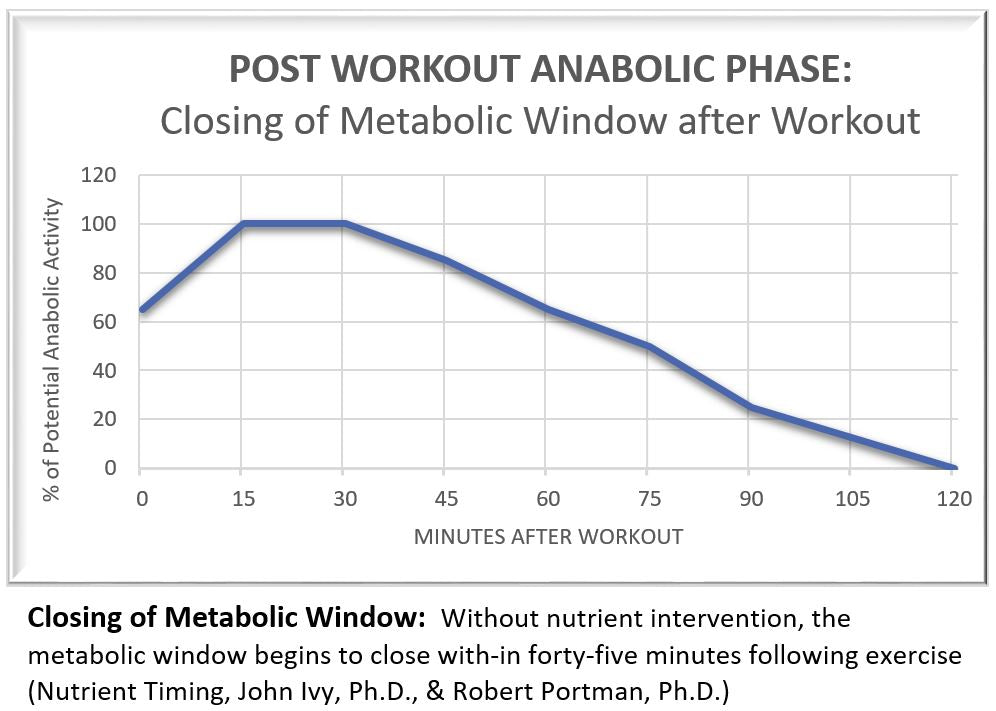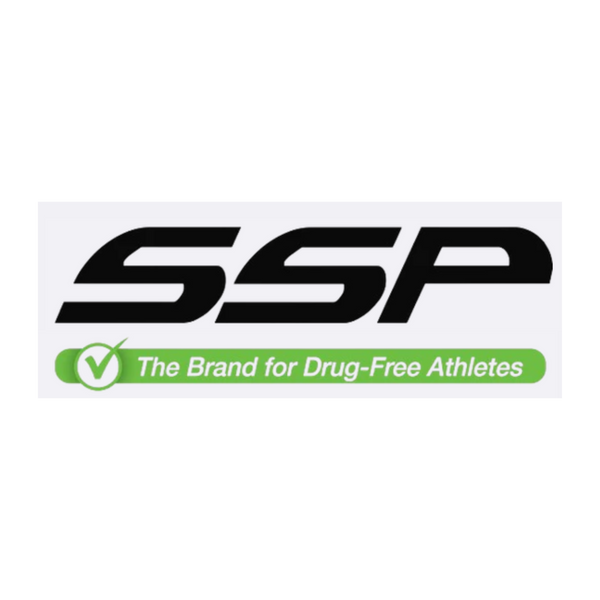
POST WORKOUT NUTRITION: THE “ANABOLIC WINDOW”
Complete article can be found at: http://mattwalrath.com/nutrient-timing-silver-bull... Written by: Matt Walrath
The Nutrient Timing System is a great resource because it is research-based and breaks down nutrient timing for exercise into a simple formula. Since its publishing, many fitness professionals have made nutrient timing recommendations based on the scientific literature that the book was based on, and I have seen many nutrition articles echo its prescriptions.
The core idea behind nutrient timing is that there are specific energy needs of the body at certain times of day. The book, Nutrient Timing System, looks specifically at your nutrition needs before, during and after exercise.
POST WORKOUT NUTRITION: THE “ANABOLIC WINDOW”
After exercise, our muscles are hungry. They just spent the last hour or so working hard to break down big complex molecules such as glycogen to generate a simple form of energy, ATP. In the process, free radicals such as hydrogen ions and a host of other metabolic waste products have been created and need to be removed from the cell before causing too much damage.
Studies have also shown that even 3 sets to failure of bicep curls can deplete 24% of glycogen in the muscle. Kick it up to 6 sets at a lower weight and we see a 38% decrease in glycogen storage.
Our muscles NEED blood flow in order to deliver nutrients, especially carbohydrate in the form of glucose, for glycogen repletion and to clear the damaging metabolic wastes created during catabolism. The hormone insulin is the key to kick starting these anabolic processes.

The increased blood flow to the muscles that insulin stimulates allows our muscle cells to replete glycogen, phosphocreatine stores, and begin removing metabolic wastes. After exercise, our muscle cells become more insulin “sensitive” and have an enhanced ability to transport glucose from the blood into the cells to manufacture and store glycogen.
So how do we stimulate the release of insulin after exercise to kick start these processes? Both carbohydrate intake and protein intake are adequate in isolation, but even more potent in combination.
Studies on nutrient timing have shown that consuming a protein + carbohydrate beverage immediately post-exercise rapidly increases the rate and total volume of glycogen repletion vs. the same beverage consumed 2 hours later.

Various studies also show that a carb and protein beverage immediately AND a few hours post workout are effective in increasing muscle protein synthesis, glycogen replenishment, reducing muscle damage, and reducing immune system suppression that results from exercise.
That is the science of nutrient timing post-workout. The art of nutrient timing revolves around determining what to eat or drink after exercise, how much to consume, and how to make it convenient to consume it as immediately as possible.
THE ANABOLIC WINDOW AFTER STRENGTH TRAINING
The research done on athletes who performed an exercise program consisting of functional movements (squat, bench, deadlift) will be more relevant to strength athletes, CrossFit athletes, and anybody engaging in high intensity weight lifting so we will focus on this subset of the literature.
Some of the studies that fit these criteria have found that a protein supplement consumed both pre and post workout has an effect on improving total muscle mass and 1 rep max strength, while others showed no significant difference between immediate consumption and later consumption.
One study did, however, look at the effect of a protein/carbohydrate/creatine blend consumed pre and post workout. This study showed a significant improvement in muscle mass and 1 rep max strength after 10 weeks in the group consuming the blend immediately pre and post workout vs. the group consuming the same blend in the morning and at night.
If your goals are to add muscle mass (which also positively effects fat loss) or to improve your athletic performance, these findings are both important and relevant to you. Experiment with consuming a carb/protein/creatine mix before and after exercise for a micro cycle of training (about 8-10 weeks) and observe whether your rate of improvement is greater than a previous baseline.
The research had subjects consuming about .45g of carb and protein combined per pound of bodyweight with 7g of creatine pre and post workout. For a 175lb male this translates to about 40g each of protein and carbohydrate with 5g of creatine pre and post workout.
For competitive fitness athletes training multiple sessions per day or 10+ hours per week, you will benefit from liquid carbohydrate supplementation both during and after exercise. I recommend about 40g of carbohydrate mixed with protein post-exercise, and based on the research it appears effective to drink this blend pre-workout as well.
If you are planning to do multiple training sessions in the same day, make sure to absolutely gorge yourself with carbohydrates after your first training session to ensure proper glycogen repletion. Studies have looked at the effects of training in a glycogen depleted vs. glycogen repleted state and have found that when training in a depleted state athletes experienced double the nitrogen loss (nitrogen loss is an indication of muscle breakdown).

POST WORKOUT NUTRITION: AFTER THE ANABOLIC WINDOW
If you consume a liquid supplement and/or a mixed meal consisting of starchy carbohydrate and protein, insulin will stay elevated and extend the anabolic window out to about 4-6 hours post-exercise. After 4-6 hours, anabolic activity continues, but at a slower rate.
At this point, our goal is simply to ensure that we are consuming enough total calories and macronutrients to replenish what we have broken down during exercise, and support lean muscle mass.
Your first goal outside of the anabolic window is to ensure you eat enough total protein to fuel muscle protein synthesis and avoid muscle protein catabolism. As discussed in previous articles, the research shows that about .82g of protein per pound of bodyweight per day is adequate.
Next, if your goal is to maintain weight, gain muscle mass, or generally improve athletic performance you want to make sure you are consuming enough total calories to maintain a neutral or positive energy balance. This means eating enough to match or exceed your caloric expenditure.
Research shows that protein synthesis continues for up to 48 hours post-workout. For this reason, consuming more vs. less protein is key to supporting muscle gains. There has also been research done which shows a positive energy balance, eating more than you burn, leads to greater gains in muscle mass.

SUMMARY
For those of you concerned with fat loss, not performance or mass gain, the most important insights from nutrient timing that you can put into action are:
Only eat starchy carbohydrates (potato, sweet potato, rice, plantian/banana, grains) and sugars (refined or from fruit) during the anabolic window when they can be used by the muscle.
Consume a liquid protein beverage post-exercise to help stimulate insulin until you can eat a whole food meal containing starchy carbohydrates.
Outside of the anabolic window, make sure to consume enough protein and keep carbohydrate intake low sticking to complex carbohydrate sources that contain fiber, such as vegetables.
For performance-oriented athletes and those interested in mass gain, the following are recommendations to experiment with:
Drink a protein/carbohydrate/creatine beverage immediately pre and post workout
Sip a 6% carbohydrate solution mixed with BCAA and glutamine (about 5-10g) during your workout.
If training twice in one day, increase your carbohydrate intake after the first training session.
Liquid supplementation pre/intra/post-workout is conducive of muscle anabolism and will reduce muscle protein breakdown. Mixed meals every 1-2 hours post-workout extends the anabolic window.
Eat a caloric surplus
SOURCES
1.Ivy, John, and Robert Portman. Nutrient Timing System: The Revolutionary New System That Adds the Missing Dimension to Sports Nutrition: The Dimension of Time. North Bergen, NJ: Basic Health Publications, 2004. Print.
2.Aragon, Alan Albert, and Brad Jon Schoenfeld. “Nutrient Timing Revisited: Is There a Post-exercise Anabolic Window?” J Int Soc Sports Nutr Journal of the International Society of Sports Nutrition 10.1 (2013): 5. Web. <http://www.biomedcentral.com/content/pdf/1550-2783-10-5.pdf>.
3.Cribb, Paul J., and Alan Hayes. “Effects of Supplement Timing and Resistance Exercise on Skeletal Muscle Hypertrophy.” Medicine & Science in Sports & Exercise 38.11 (2006): 1918-925. Web. <https://www.purdue.edu/swo/nutrition/KnowItAll/HealthyWeightGain/EffectOfSupplTiming&ResistanceExcerciseOfSkeletalMuscleHypertrophy.pdf>.
4.Hulmi, Juha J., Vuokko Kovanen, Harri Selänne, William J. Kraemer, Keijo Häkkinen, and Antti A. Mero. “Acute and Long-term Effects of Resistance Exercise with or without Protein Ingestion on Muscle Hypertrophy and Gene Expression.” Amino Acids 37.2 (2008): 297-308. Web. <http://www.ncbi.nlm.nih.gov/pubmed/18661258>.
5.Hoffman, Jay R., Nicholas A. Ratamess, Christopher P. Tranchina, Stefanie L. Rashti, Jie Kang, and Avery D. Faigenbaum. “Effect Of Protein Supplement Timing On Strength, Power And Body Compositional Changes In Resistance-trained Men.” Medicine & Science in Sports & Exercise 41.Supplement 1 (2009): 303. Web. <http://www.ncbi.nlm.nih.gov/pubmed/19478342>.
6.Willoughby, D. S., J. R. Stout, and C. D. Wilborn. “Effects of Resistance Training and Protein plus Amino Acid Supplementation on Muscle Anabolism, Mass, and Strength.” Amino Acids 32.4 (2006): 467-77. Web. <http://www.researchgate.net/publication/6805348_Effects_of_resistance_training_and_protein_plus_amino_acid_supplementation_on_muscle_anabolism_mass_and_strength>.
7.http://www.ncbi.nlm.nih.gov/pubmed/1601794
8.Roy, B. D., M. A. Tamopolsky, J. D. Macdougall, J. Fowles, and K. E. Yarasheski. “The Effect Of Oral Glucose Supplements On Muscle Protein Synthesis Following Resistance Training 769.” Medicine & Science in Sports & Exercise 28.Supplement (1996): 129. Web. <http://jap.physiology.org/content/82/6/1882>.
9.Nieman, David C., Sandra L. Nehlsen-Cannarella, Omar R. Fagoaga, Dru A. Henson, Alan Utter, J. Mark Davis, Franklin Williams, and Diane E. Butterworth. “Influence of Mode and Carbohydrate on the Cytokine Response to Heavy Exertion.” Medicine & Science in Sports & Exercise30.5 (1998): 671-78. Web. <http://www.ncbi.nlm.nih.gov/pubmed/9588607>.

27 comments
http://mewkid.net/when-is-xuxlya3/ – Amoxicillin 500mg Capsules Dosage For Amoxicillin 500mg xof.eilf.sspnutrition.com.bmg.hx http://mewkid.net/when-is-xuxlya3/
http://mewkid.net/when-is-xuxlya3/ – Amoxicillin 500mg Buy Amoxicillin Online csk.xyke.sspnutrition.com.unq.oq http://mewkid.net/when-is-xuxlya3/
http://mewkid.net/when-is-xuxlya3/ – Amoxicillin 500 Mg Amoxicillin Without Prescription bag.lonj.sspnutrition.com.yhz.ep http://mewkid.net/when-is-xuxlya3/
http://mewkid.net/when-is-xuxlya3/ – Amoxicillin Amoxicillin 500mg Capsules knz.swzr.sspnutrition.com.vtd.mx http://mewkid.net/when-is-xuxlya3/
http://mewkid.net/when-is-xuxlya3/ – Buy Amoxicillin Amoxicillin uaz.ljzl.sspnutrition.com.fgz.hp http://mewkid.net/when-is-xuxlya3/